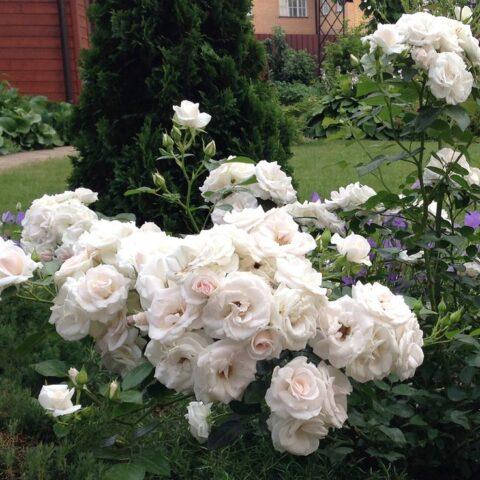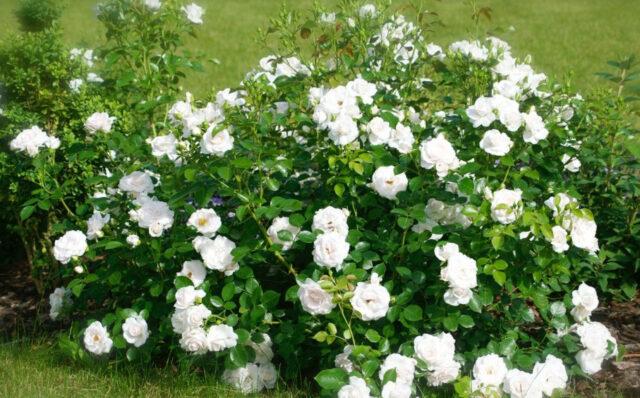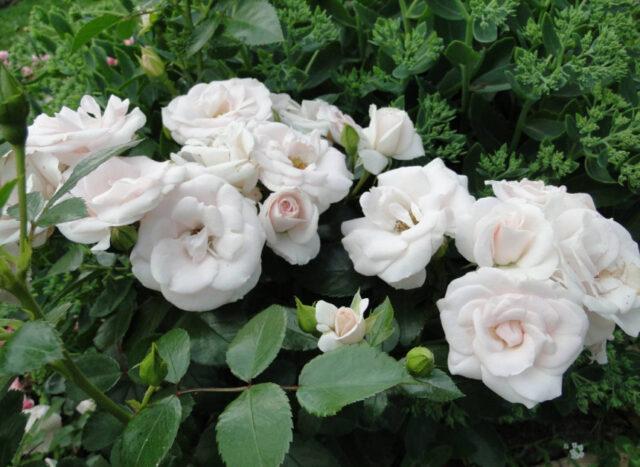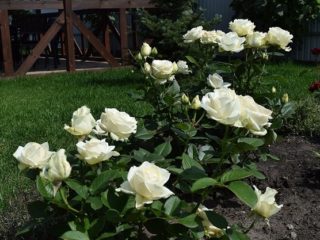Content
- 1 Breeding history
- 2 Description and characteristics of the variety of roses floribunda Aspirin
- 3 Advantages and disadvantages of the variety
- 4 Reproduction methods
- 5 Planting and caring for a rose Aspirin
- 6 Pests and diseases
- 7 Rose aspirin in design
- 8 Conclusion
- 9 Reviews with a photo of a rose floribunda Aspirin Rose
Rose Aspirin is a versatile flower that is grown as a patio, groundcover, or floribunda. Suitable for flower beds, containers, group and single plantings, does not fade for a long time in the cut state. It blooms with buds of a white and pinkish hue for a long time and abundantly. Flowers densely cover the bushes with large tassels, look graceful and delicate. Aspirin is inferior to its relatives in size, but does not lose in wealth and splendor of flowering.
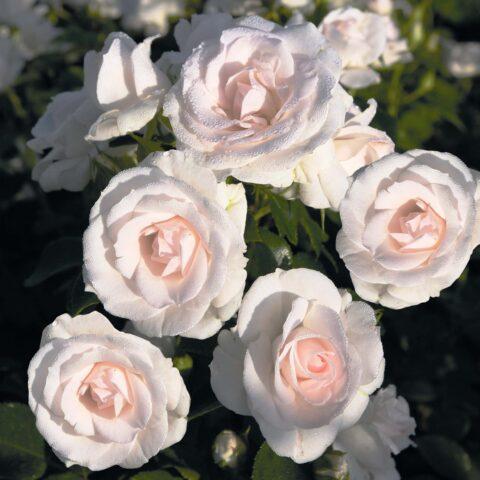
Aspirin Rose blooms profusely and continuously, covering the entire shrub with lush buds
Breeding history
Floribunda Aspirin rose was developed by Tantau in Germany twenty three years ago. The author of the selection is Hans Jürgen Evers. The plant got its name in honor of a common drug, since it appeared on the day of the centenary of the drug. It is also known that in 1996 the variety received the ADR certificate.
Description and characteristics of the variety of roses floribunda Aspirin
Aspirin Rose belongs to the category of ground cover or climbing miniature roses. It fits perfectly into both small cozy front gardens and large landscape compositions. It is considered the easiest and easiest variety to grow. Ideal for beginners.
The rose bush blooms profusely, all the buds bloom almost simultaneously, and after the crumbled inflorescences new ones appear. Flowering is repeated, prolonged, occurs for four to five months. The budding period lasts from early June to late October.
Aspirin Rose flowers are lush, beautiful, have different sizes, some can reach 80 mm in diameter, grow close to each other. The heart of the inflorescence is hidden because the petals are packed tightly. The buds are similar to the classic rose, cupped, white. With the beginning of flowering in the center, they have a pale pink tint, if the weather is cool, it is more pronounced. When the buds open fully, their color becomes snow-white, a faint but very pleasant aroma appears. The foliage of Aspirin Rose is small, smooth, without chipping, with a glossy surface. It has a rich dark green color and an oval shape.
Perennial bushes are sprawling, beautifully shaped, grow in width more than in height (0.8 and 0.5 m), thin shoots. Up to 15 double buds can form on each brush, which gives the impression that the rose is completely covered with flowers. Each Aspirin Rose inflorescence has about fifty petals, which have one distinctive feature: they begin to fall off before they lose color. For this reason, the plant always looks neat and tidy.
Another significant advantage of Rose Aspirin is that it has good immunity, with proper care and cultivation in a suitable place, it is resistant to almost all diseases common among roses - such as black spot, powdery mildew. In addition, she feels great during unfavorable weather conditions, easily tolerates winter (the frost resistance zone of the variety is the fifth).
Advantages and disadvantages of the variety
This variety of floribunda has a number of advantages and disadvantages.
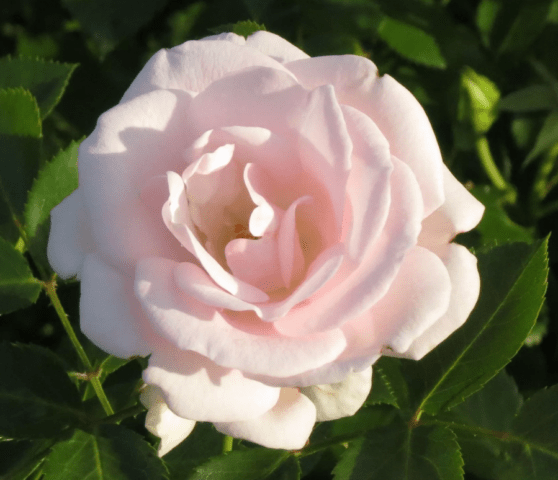
Rosebud color may vary depending on temperature and light
The main advantages of Aspirin Rose include:
- continuous long flowering;
- lush buds and densely leafy bushes;
- persistent immunity to disease;
- good frost resistance;
- versatility in use;
- suitability for cutting.
The disadvantages of the variety are:
- subtle smell;
- inconvenience of processing the area around the bush.
Reproduction methods
The rose bush Aspirin Rose can only reproduce vegetatively. As a rule, most gardeners use the cuttings method, which is carried out after the first flowering, in June. To do this, cut off a shoot 10 cm long, 10 mm under the bud and 20 mm from the eye. Then it is placed in a growth stimulator for several minutes and planted in fertile soil. After about three weeks, the cutting will give roots, and the next year it will be ready to be planted in a permanent place.
Bushes with strong and long shoots are propagated by layering, they are laid in grooves of shallow depth, sprinkled with earth, watering is carried out as necessary. When leaves appear on the seedlings, they are separated from the bush and planted in a flower bed.
Reproduction by division is carried out in the spring, and only if the rose is more than four years old.
Planting and caring for a rose Aspirin
In regions with warm winters, the Aspirin Rose ground cover rose is best planted in the fall, with cold - in the spring. In the first case, the seedlings are shortened by 15 cm before planting, in the second - by 20-25 cm.In strong cuttings, three buds are left, in weak ones - one or two. The most successful place for planting culture is a hill, where melt water and moisture do not stagnate. The site should be with fertile soil, before planting it should be cleared of weeds, loosened and treated with Roundup. After that, you need to dig a small hole 30 cm deep, lay crushed stone, manure, peat, sand on its bottom, place a stalk, cover it with earth and water it.
Throughout the season, it is recommended to carry out standard care for Aspirin Rose:
- Watering is carried out early in the morning or in the evening, when the soil under the bush dries out 2-3 cm deep.
- Aspirin should be fertilized at least four times during the growing season: during the formation of leaves, thirty days later, at the end of the first wave of flowering, before the onset of winter.Attention! The first three dressings should be carried out with nitrogen, potassium, phosphorus in a ratio of 1: 1: 2, during the last, preferably, K.
- It is advised to prune this variety twice a year - in spring and autumn. After winter, you need to cut off all the shoots affected by the cold at the root, before the onset of frost, shorten the infected and heavily overgrown branches by 20 cm.
- The plant is covered with special material or spruce branches, but only if it grows in a region with severe frosts (-28 ° C and below).Comment! Aspirin Rose tightly covers the flowerbed with flexible shoots, so loosen the soil and remove weeds in the spring, before intensive growth begins.
For abundant flowering, the plant requires balanced and properly selected fertilizing.
Pests and diseases
Aspirin Rose is a variety with very high resistance to many diseases. Those ailments that are rare, but likely to be encountered when growing a rose, include:
- black spot;
- powdery mildew;
- rust (in contaminated areas).
Usually, a plant only gets sick if it is not cared for at all. If an "infection" is found, the perennial should be treated immediately with "Aktellik" or "Intra-Vir".
The variety is rarely affected by insects. When attacking pests, it is enough to spray the bush with insecticides.
Rose aspirin in design
In the garden, the Aspirin Rose looks great. It can be used in the design of any landscape design, since it is a combination of three types at once: patio, ground cover, floribunda.
The plant looks interesting when several bushes are planted side by side, when the falling branches, covering the soil, form a solid green carpet with white flowers. Since the rose is miniature, it looks great in pots and flowerpots. Many gardeners plant Aspirin as a floribunda in group beds and mixborders. Best of all, its buds are combined with flowers of yellow, blue, red and purple shades.
The variety is well suited for cutting, looks great in compositions. In a vase of water, a bouquet of Aspirin Rose can last longer than a week.

Flowers of this variety of roses are suitable for making bouquets and compositions.
Conclusion
Rosa Aspirin is a variety with good health, high resistance and special appearance. With proper care, a perennial annually pleases its owner with high-quality, abundant and long flowering. The buds of miniature Aspirin Rose are lush and beautiful, exuding a faint but very pleasant aroma. The variety is great for beginner amateur flower growers.
